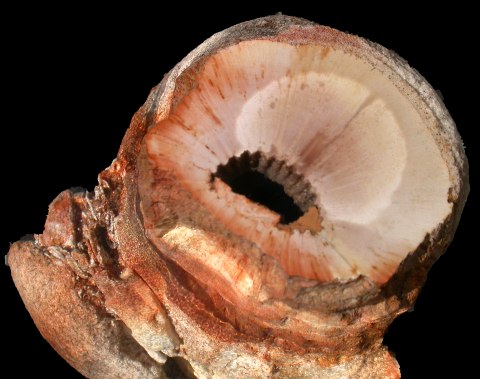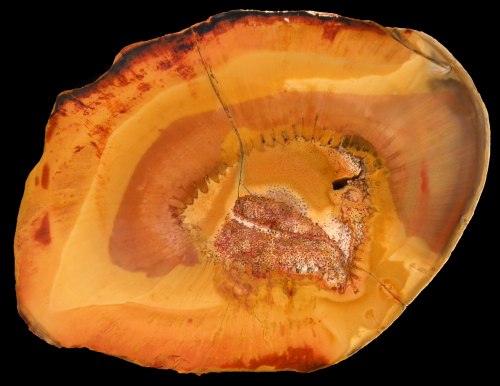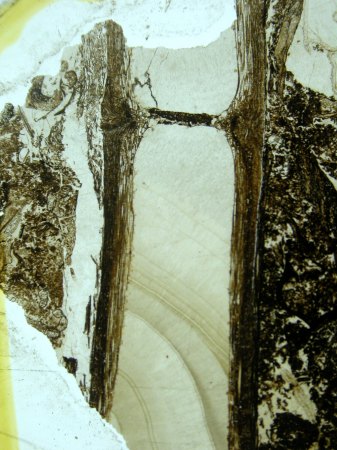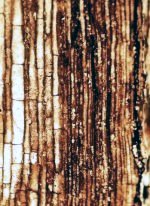Calamites is one of the most well-known fossils of the Carboniferous and the Permian. It is found as a stem with a longitudinal ribbing and, at some distance from each other, transverse lines or nodes. In most cases the stem of Calamites is flattened, but sometimes it is more or less threedimensional. In this case the fossil shows no internal structure: it is just petrified sediment. This is the reason that it is difficult to get an impression of the composition of the Calamites tree.
Rarely however stems and branches are preserved extraordinary well, i.e. when they have been mineralized as a consequence of exceptional circumstances. This is for example the case in the Lower Permian depositions of Chemnitz (Germany), where the trunks are silicified as a result of an enormous vulcano eruption. In the renewed Museum für Naturkunde in this city the worlds biggest Calamites trunk is displayed. And it is structurally preserved!
Coal balls
An other example of exceptional preservation is that of the coal balls. These
are concretions of calcium carbonate and/or other minerals, occurring in
some of the coal seams of the Upper Carboniferous (Pennsylvanian). They have
been found in the coalfields of Lancashire and Yorkshire in England and in
several places in the USA.
The microphotos in this chapter are taken from a couple of thin sections
from coals balls, which were bought in 1922 by the University of Groningen
(NL) from a laboratory in England.
Casts
The transverse sections of the two small trunks below show a serrated edge.
In the stem on the left is an empty space to the inner side of the edge,
in one on the right this space is filled with amorphous sediment. In young
plants this central cavity was filled with thinwalled parenchym cells (pith),
whereas in older trunks pith only occured in the outer regions of the central
cavity.
 |
 |
Calamites stems from the Permian of Brasil. Inside the serrated edge is the central cavity. |
|
 Most of the fossils
of Calamites are casts of the central cylinder of the trunk. After
the tree had died, this cavity got full of sediment, after which the bark
and the wood of the trunk decayed. So only a cast of the central cylinder
remained. The longitudinal ribbing on it is the counterpart of the serrate
pattern on the inside of the central cavity.
Most of the fossils
of Calamites are casts of the central cylinder of the trunk. After
the tree had died, this cavity got full of sediment, after which the bark
and the wood of the trunk decayed. So only a cast of the central cylinder
remained. The longitudinal ribbing on it is the counterpart of the serrate
pattern on the inside of the central cavity.
The transverse lines at the cast indicate where the diaphragms were placed
in the central cylinder. These diaphragms or nodes are characteristic for
horsetails. They gave rise to the wirls of leaves and branches.
The photo to the left shows a transverse section of a diaphragm in a stem
of Calamites in a coal ball. Click on the photo for enlargement.
Structure of a Calamites stem
|
|
Transverse section of a stem of Calamite |
Bundle of wood vessels |
Look at the drawings above. In the transverse section the circle with
the small round holes attracks attention. At the place of those holes
the very first wood vessels (the protoxylem) of the young plant were
located. These were of a very small diameter. Around them the
metaxylem developed, also with very narrow cells. Next the secundary
growth started from the cambium, a one-cell-thick layer of tissue, forming
secondary wood to the inner side and no phloem to the outer side.
It was a unifacial cambium. In the course of this process canals arose at
the place of the protoxylem and the metaxylem. These are called carinal
canals. So the holes are transverse sections of these carinal
canals.
Between the successsive xylem bundles protrusions of the pith were formed:
the rays. These are, however, not always present. In the latter case
the secondary wood forms a unbroken cylinder.
In the, rarely preserved, bark are air ducts at regular distances from each other. They are called vallecular canals. Because of these canals the outside of the living Calamites tree showed longitudinal grooves and ribs. This ribbing is seldom visible because the bark is hardly ever preserved.
Photos of stems of Calamites in coal ball
slides
Click on the photo to enlarge it. Click Zoom to explore the photos
in detail (fast internet recommended).
Genera
Three genera are distinguished in structurally preserved stems of
Calamites. The above described kind of wood is called
Arthropitys. It is the most common type. Moreover Arthroxylon
and Calamodendron have been described. The differences are found mainly
in the way the parenchym cells are situated amongs the wood cells. It is
not certain whether these characteristics have systematical significance
or not. It is possible that they have to do with development stages or with
the place in the trunk.
Bordered pits
 The cells of
the secondary wood are very elongated in the longitudinal direction of the
stem.
The cells of
the secondary wood are very elongated in the longitudinal direction of the
stem.
To the left in the picture lay the pith cells, to the right the wood cells.
The latter provide stiffness and they manage the water transport. They are
called tracheids. The water moves from one tracheid to an adjacent
one through holes in the radial cell walls. These holes are sometimes the
centre of a so-called bordered pit (a circular area with a hole in the middle),
but ladder-like structures occur also. Click on the photo for more
details.
Summarizing it can be said that the horsetail trees have achieved a maximum
of solidity, thanks to a very efficient way of wood production. The cylindrical
structure with a large central cavity appeared to work very well. The proof
is that horsetail trees could reach a size of about 20 m. Their extinction
will not have been caused by the woodstructure.
Literature
Remy W, and Remy R., 1977. Die Floren des Erdaltertums.Glückauf, Essen
(Germany).
Stewart, W.N., and Rothwell G.W., 1993. Paleobotany and the evolution of
plants. University Press, Cambridge (UK).
Taylor T.N., and Taylor E.L., 1993. The biology and evolution of fossil plants.
Prentice Hall, New Jersey (USA).